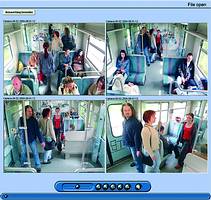
The decision in November 2004 by the South African Courts that the various railway authorities are responsible for passenger safety, and not the SAPS, has seriously concentrated minds onto security. The difficulty for each railway authority is the number of parties claiming solutions, and with limited time frames in place for the World Cup Soccer it is an unenviable task to find the right solution that will work. This is where careful consideration needs to be given to those proven solutions currently in use in the international market. Time is short and it is important that a proven product with the relevant track record and history is chosen if we are to get it right considering the conceivable likely costs.

The biggest problems arise in the train carriage and on the platforms when there is a large conglomeration of passengers, where it is difficult for an observer to see what is going on and to earmark an offender. By careful placement of cameras and use of current technologies it has been proven in many situations for the capture of the required evidence for arrest and successful prosecution.
Platforms are relatively easy to monitor with the careful placement of correct cameras and their link to local, provincial and central control rooms. Storage can be on-site through standard DVRs or off-site, assuming that bandwidth is available, thus allowing a mix of conventional CCTV cameras and IP cameras. In fact, using a mix of cameras routed back to suitably accommodating DVRs will cover most situations and with integration to a Central Management Information System opens the door to a myriad of integration options for biometrics, access control and ANPR for parking and drop off areas amongst a number of options. Train carriages in motion are a totally different requirement and the first consideration needs to be given to internationally recognised approvals and certifications - a standard DVR with a standard camera will not work!
In a standard train configuration we expect to see three carriages and one engine acting as a four carriage unit, these can also be combined to give a two or three unit train amounting to eight or 12 carriages. If each carriage is more than 20 metres in length with the possibility of six or more exit and entry points then securing this area internally to any degree is a major exercise. In addition, when one wants external cameras to cover platform action, as well as mounting and dismounting of passengers to/from the train then the factors increase markedly. In this type of scenario one could expect to require control of more than one hundred cameras to achieve complete coverage.
Stability of the system is of paramount importance. Understanding the various issues that affect the longer-term use of any system is a large part of providing a total solution. Trains normally run on 110 V and power is supplied in South Africa normally via overhead cabling, this power supply fluctuates and surges giving a lot of headaches for successful system operation. In addition trains travel at up to 100 km per hour bumping and grinding over inconsistently laid tracks that create shock and vibration. Temperature variation is another problem as carriages are often heated or in many cases not heated and during a cold winter, temperatures can be below freezing. The final concern is the human factor of damage and vandalism; fire, water, paint, bullets, and the many other variables open to the imagination. The right approvals and certifications will assist with most of the above requirements but it is success in operation that counts and FleetVu offers a less than 3% failure rate with more than 6000 systems in use over the past 10 years.
Providing an African solution will probably require the use of a simpler analog solution - combining video and data transmission over coupler points via twisted pair or through existing ELA 100 V power. Not as effective as the digital solution in view of transfer rates but still capable of fulfilling the mandate; the driver, guard and security team can have access to all cameras on the train at the push of a button.
The digital solution - video and data transmission over coupling points provided by a train video network over CAT 6 cable. This will give a full 100 Mb of transfer speed on the train network combined with the use of Train Video Monitors - gives all required parties intelligent processing through smart monitoring. In addition Vision Catcher is testing and finalising the ability to download data on the move, to nodal points allowing the realtime transfer of critical information to central points for relevant action. Therefore, an incident can be reported with relevant footage and the security and police can be waiting at the next station to isolate and apprehend those parties involved.

The key to the success for African railways is getting it right first time - quality of picture that allows for successful prosecution from a system that works and survives the rigours of a stressful life in a mobile environment.
For more information contact Niall Beazley, Vision Catcher, 011 463 9797, [email protected], www.visioncatcher.co.za

© Technews Publishing (Pty) Ltd. | All Rights Reserved.